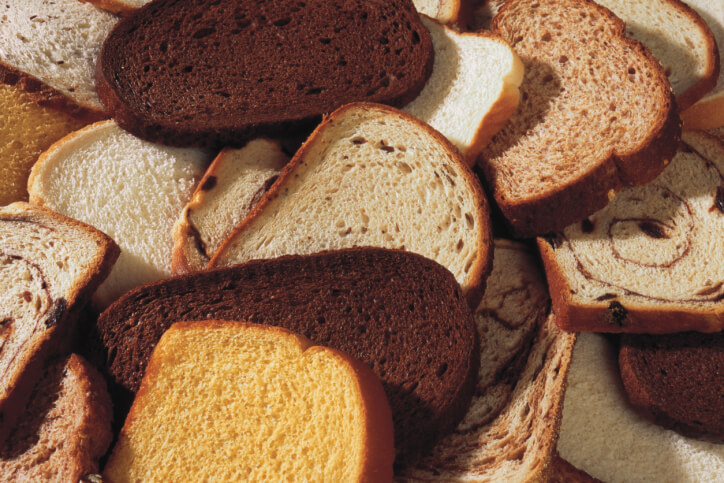
-
50 nyanser av glutenproblem
De senaste artiklarna om gluten som cirkulerar i dagspress och på sociala medier sprider felaktiga uppgifter om att gluten skulle vara något som de flesta tål. Sanningen är precis tvärtom. Gluten är något som ingen människa kan bryta ner och väldigt många reagerar på gluten utan att vara glutenintoleranta eller ha celiaki.
Gluten kan trigga igång inflammation i kroppen utan att du får en diagnos av doktorn. En dominerande del av alla som lider av autoimmuna sjukdomar blir betydligt bättre eller lyckas att häva sjukdomen helt när de utesluter gluten, trots att de enligt svensk sjukvård ”tål” gluten. Detta beror på att de man vid testerna endast tittar på känslighet mot en enda del av glutenproteinet (alphpa-gliadin) och ett enda enzym (transglutamin tTG-2) trots att det finns en hel rad med övriga gliadiner och enzymer i gluten. Det är som om man bara skulle testa en pollenallergiker för hund och häst och inga andra typer av allergener (de flesta är även de proteiner) och sen ställa diagnos utifrån det.
Bästa testet gör du själv genom att utesluta gluten och se hur du reagerar. Mår du bättre har du ju inget att förlora, gluten är inte något som människan behöver i sin kost. Om du inte är sjuk så kan glutenfri kost vara bra i förebyggande syfte. Forskning visar att gluten kan påverka så gott som alla olika delar i kroppen; hjärnan, huden, magen, levern, blodådrorna, muskler och lymfsystemet för att nämna några.
Chris Kresser beskriver problematiken ingående i följande artikel. Längst ner hittar du även vår expert Karl Hulténs fakta om gluten och autoimmunitet. God läsning och sprid gärna vidare! / Cecilia
Chris Kresser
50 Shades of Gluten (Intolerance)
This article was first featured at The Huffington Post. Click here to see the original article.
Celiac disease (CD) was initially described in the first century A.D. by a Greek physician named Aretaeus of Cappadocia. (1) But neither Aretaeus nor anyone else knew that CD is caused by an autoimmune reaction to gluten, a protein in wheat. That didn’t become clear until 1950 — several centuries later — when Dr. Willem Dicke, a Dutch pediatrician, conclusively proved that gluten was the culprit. (2) Dicke’s discovery saved millions of children and adults from the perils of untreated celiac disease, including malnutrition, stunted growth, cancer, severe neurological and psychiatric illness and even death.
Since then, the mainstream view of gluten intolerance has been relatively black or white: Either you have celiac disease, in which case even a small amount of gluten will send you running to the bathroom in three seconds flat, or you don’t, and you can chug down beer and bagels without fear. This “all-or-nothing” view has led to some doctors telling patients that suspect they’re sensitive to gluten but test negative for CD that they’re simply imagining an affliction that doesn’t exist.
It turns out those doctors are wrong.
The Many Shades of Gluten Intolerance
In order to explain why, I have to give you a quick lesson in the biochemistry of wheat and wheat digestion.
Wheat contains several different classes of proteins. Gliadins and glutenins are the two main components of the gluten fraction of the wheat seed. (They’re essential for giving bread the ability to rise properly during baking.) Within the gliadin class, there are four different epitopes (i.e. types): alpha-, beta-, gamma- and omega-gliadin. Wheat also contains agglutinins (proteins that bind to sugar) and prodynorphins (proteins involved with cellular communication). Once wheat is consumed, enzymes in the digestive tract called tissue transglutaminases (tTG) help to break down the wheat compound. In this process, additional proteins are formed, including deamidated gliadin and gliadorphins (aka gluteomorphins).
Here’s the crucial thing to understand: Celiac disease is characterized by an immune response to a specific epitope of gliadin (alpha-gliadin) and a specific type of transglutaminase (tTG-2). But we now know that people can (and do) react to several other components of wheat and gluten — including other epitopes of gliadin (beta, gamma, omega), glutenin, WGA and deamidated gliadin — as well as other types of transglutaminase, including type 3 (primarily found in the skin) and type 6 (primarily found in the brain). (3, 4, 5, 6, 7, 8)
This is a huge problem because conventional lab testing for CD and of gluten intolerance only screens for antibodies to alpha-gliadin and transglutaminase-2. If you’re reacting to any other fractions of the wheat protein (e.g., beta-gliadin, gamma-gliadin or omega-gliadin), or any other types of transglutaminase (e.g., type 3 or type 6), you’ll test negative for CD and gluten intolerance no matter how severely you’re reacting to wheat.
Beyond Celiac: Why CD Is Just the Tip of the Iceberg
Official statistics suggest that Celiac disease affects between 0.7 percent and 1 percent of the U.S. population. (9) But considering the limited scope of the testing, it’s possible that the actual incidence might be much higher.
In addition, CD is only the tip of the iceberg when it comes to gluten intolerance. Celiac disease is caused by a distinct autoimmune response to wheat proteins and transglutaminase enzymes in the gut. But CD is just one possible expression of gluten intolerance; there are many other ways that sensitivity to gluten can manifest in the body. These are collectively referred to as “Non-Celiac Gluten Sensitivity,” or NCGS.
There’s no consensus definition of NCGS yet, but the most common understanding is that it’s a reaction to gluten that is not autoimmune (like CD) or allergic (like wheat allergy). Another definition I’ve seen is, “a reaction to gluten that resolves when gluten is removed from the diet and CD and allergy have been ruled out.” (10)
It’s difficult to estimate the prevalence of NCGS because there is no definitive diagnostic test for it. As I mentioned above, the currently available tests for gluten sensitivity are primitive and only screen for a small fraction of the components of wheat that people react to. Another issue is the variety of symptoms caused by CD and NCGS. While most people assume that gluten intolerance always causes digestive distress, this is not the case. Almost 50 percent of new patients diagnosed with CD do not have gastrointestinal symptoms. (11) Moreover, for every one case of CD that is diagnosed, there are 6.4 cases that remain undiagnosed — the majority of which are atypical or silent forms without gastrointestinal symptoms. (12)
Gluten intolerance can affect nearly every tissue in the body, including the brain, skin, endocrine system, stomach, liver, blood vessels, smooth muscles and even the nucleus of cells. CD and NCGS are associated with an astonishing variety of diseases, from schizophrenia and epilepsy, to Type 1 diabetes and osteoporosis, to dermatitis and psoriasis, to Hashimoto’s hypothyroidism to peripheral neuropathy. (13) Because the range of symptoms associated with gluten intolerance is so broad and nonspecific (e.g., can be attributed to any number of conditions), many patients and doctors don’t suspect gluten may be the cause.
Even with these limitations, some estimates suggest NCGS may occur in as many as 1 in 20 Americans. (14) And while some mainstream medical professionals continue to insist that NCGS doesn’t exist, several studies have validated it as a distinct clinical condition — including gold-standard, double-blind, placebo-controlled trials. (15)
The Gluten-Free Challenge: Still the Best Test for Gluten Intolerance
With all of this in mind, the obvious question that arises is, “What’s the best way to test for gluten intolerance?” Because of the limitations of current laboratory testing I described above, most experts on gluten sensitivity agree that the only reliable test is a “gluten challenge.” This involves removing gluten from the diet completely for a period of at least 30 days, and then adding it back in after that. If symptoms improve during the elimination period, and return when gluten is reintroduced, a diagnosis of NCGS can be made.
However, for many people a gluten-free diet isn’t enough. Some grains that don’t contain gluten, such as corn, oats and rice, contain proteins that are similar enough in structure to gluten to elicit an immune response in people with CD or NCGS. In addition, about 50 percent of patients with CD show signs of intolerance to casein, the protein in milk. (16) This may explain why up to 30 percent of CD patients continue to have symptoms or clinical signs after adopting a gluten-free diet. (17) For this reason, I recommend a completely grain- and dairy-free diet during the gluten challenge period.”
Karl Hultén
Det har länge varit känt att det finns en koppling mellan glutenintolerans (celiaki) och flera andra autoimmuna sjukdomar. Tidigare har man förklarat detta med att det måste finnas en gemensam genetisk faktor som är utlösande. Men senare tids forskning visar att gluten i stället kan den gemensamma nämnaren.
 Nära en miljon svenskar har en autoimmun sjukdom där några av de vanligaste är reumatism (reumatoid artrit), multipel skleros, celiaki (glutenintolerans), alopecia, typ 1-diabetes, giftstruma, autoimmun tyreoidit, vititiligo, crohns, ulcerös kolit och IBS (ej erkänd som autoimmun).
Nära en miljon svenskar har en autoimmun sjukdom där några av de vanligaste är reumatism (reumatoid artrit), multipel skleros, celiaki (glutenintolerans), alopecia, typ 1-diabetes, giftstruma, autoimmun tyreoidit, vititiligo, crohns, ulcerös kolit och IBS (ej erkänd som autoimmun).
Vid autoimmuna sjukdomar angriper kroppens eget immunförsvar egen vävnad vilket orsakar olika symptom beroende på vilken vävnad som attackeras. Orsakerna till sjukdomen är både ärftliga och miljömässiga. Med andra ord så har den som blir sjuk en genetisk känslighet som utlöses av en eller flera miljöfaktorer. När jag arbetar med klienter har jag noterat att symptomen av de flesta autoimmuna sjukdomar tycks förbättras när man utesluter gluten (med flera andra livsmedel) ur dieten. Men vilken är förklaringen till det egentligen?
En av de autoimmuna sjukdomarna sticker ut
Det finns en av de autoimmuna sjukdomarna sjukdomar som skiljer sig från de övriga genom att den har ett botemedel nämligen celiaki (glutenintolerans). Kan denna sjukdom fungera som en utgångspunkt för att förstå varför så många med autoimmunitet blir bättre av att utesluta gluten ur kosten?
I den här studien från Journal of Gasteroenterology har man visat att den tid som personer med celiaki utsätts för gluten är helt avgörande för om de ska utveckla fler autoimmuna sjukdomar. Man har länge vetat att gluten allergiker ofta utvecklar andra autoimmunitet med tiden om de inte får sin diagnos i tid. Vad man upptäckte i den här studien var att en annan autoimmun sjukdom nämligen den inflammatoriska tarmsjukdomen Crohn’s också har detta samband.
Läckande tarm och autoimmun sjukdom
Ett annat samband som de flesta inte känner till i dag är att samtliga undersökta autoimmuna sjukdomar också medför läckande tarm (ökad intestinal permeabilitet) hos den som har sjukdomen. När läckande tarm uppstår så aktiveras immunförsvaret under tarmväggen och samtidigt utsätts det för tarminnehåll som kan innehålla mikroorganismer som orsakar en korsreaktion. Det som då händer är att kroppen inte kan skilja mellan det som kommer in genom tarmväggen och en annan kroppsegen vävnad.
I den här studien har man funnit att det finns ett samband mellan glutenexponering och uppkomst av typ-1 diabetes. Författarna till studien hävdar att just förlusten av tarmens integritet tycks ligga till grund för uppkomsten av autoimmuna reaktioner.
Det finns också andra faktorer i kosten som kan bidra till läckande tarm. Dessa utesluter vi ofta när jag arbetar med klienter. Sedan är det viktigt att komma ihåg att inte bara gluten är boven bakom uppkomsten av autoimmunitet även om symptomen av sjukdomen ofta blir bättre. Autoimmunitet är ett relativt nytt fenomen som uppkommit efter det att vi börjat ha gluten som en del av vår kost. Visserligen har mängden gluten vi får i oss i dag ökat, men jag anser att det behövs fler pusselbitar för att förklara autoimmunitet.










Kommentarer
Intressant!
Tack för att du tycker till!
Tack snälla!
Jag delar vidare till de som behöver det mest
Tack så mycket!
På svenska tack!!!
Bara rubriken gör ju att man undrar,det är mycket som inte är bra att äta… Det är ju ingen som äter enbart gluten, det är ju bara en liten del av sädesslaget. Tyvärr så innhåller bröd med alldeles för många ingredienser. Tror det är de andra ämnena som finns i bröd och kakor som tyvärr är boven i dramat.